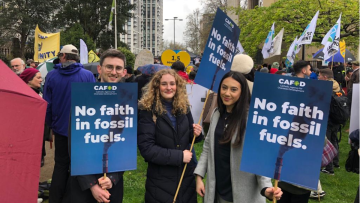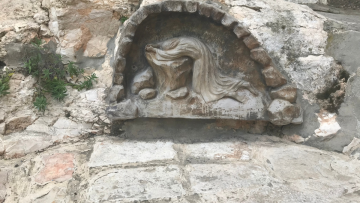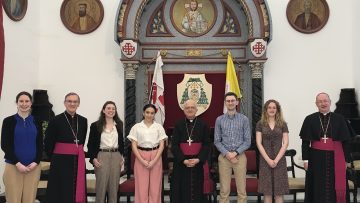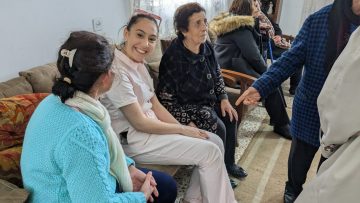Dear Diary: The Holy Land, Days 1 and 2

Bishop John Arnold shares snippets of his diary entries during his time in the Holy Land with the Faith in Politics interns.
I am making a brief visit to the Holy Land. It is just Monday to Friday, 13th-17th March. The reason for the trip is to accompany the four Parliamentary Interns of the Bishops’ Conference on one of their trips during their internship. I have had a role in the recruitment of the interns for about fifteen years, but I have only ever been part of the selection process, the interviews, and the occasional event in London. It seemed right that I should make at least one of the trips that each group of interns make during their internship year.
The group comprises, four interns, two members of Conference staff who direct them, Bishop Richard Moth and me.
Day 1 – Monday 13th March
Ziad was the taxi driver ready to meet me at the airport. He was a delightful character. Born in Jerusalem, he told me much about the present difficulties which make life so uncertain. He was a graduate in Business Development at Bethlehem University but, in his final year, he had passed tests to drive taxis and coaches as he felt that he would never find a job suiting his qualification. He now has his own taxi company and, like so many Palestinians, his welfare relies almost entirely on tourism and pilgrimage work. He explained much of the difficulties of life as a Muslim Palestinian living in Jerusalem.
Day 2 – Tuesday 14th March
After a rather splendid buffet breakfast at our hostel we started out on a demanding morning of visits to the various Holy Sites on the Mount of Olives. I should explain at this point that +Richard is something of a scholar on the history and the events in Jerusalem. He has been here 31 times and has obviously accumulated a great deal of facts and information. Much of the historical knowledge included here will be as a result of his instruction.
We walked from our hostel in the Christian Quarter through the Old City. Although I have been to Jerusalem before, I doubt that I have learned as much about the Mount of Olives as I did today. We went first to the Grotto of Gethsemane, to a chapel where it is remembered that the disciples fell asleep when Our Lord went off to pray in the Garden. We celebrated Mass in this beautiful cavern, in the simplicity of its stone walls.

Although I have been to Jerusalem before, I doubt that I have learned as much about the Mount of Olives as I did today.
From there we took a taxi for the short but steep ride up the Mount of Olives to the Pater Noster Church and had the spectacular view of the city of Jerusalem. +Richard gave an excellent presentation on the changing shape of the city walls, over the centuries, and pointed out various sites associated with the Gospel events. From there we moved to Domus Flevit; the church which commemorates the moment when Jesus wept over Jerusalem. The next stop was the Russian Orthodox church and convent of St Mary Magdalene, with its golden domes. We had time to visit the Church of all Nations and to visit the Garden of Gethsemane, which is much more extensive than I had remembered.
Our next stop was to the Basilica of St Peter in Gallicantu. This is believed to be the site of the House of Caiaphas, the High Priest, who was instrumental in the condemnation of Jesus. +Richard explained the route by which Jesus, once arrested in the Garden of Gethsemane, would have been taken to the House of Caiaphas, by a stairwell which is still recognizable. The Church has been renovated in recent years to retain access to what are believed to be the cisterns in which Christ would have been kept on the night of his arrest which would have had little or no natural light. From St Peter’s in Gallicantu there were distant views of the mountains of Jordan and also our first glimpse of the Separation Wall.
From St Peter’s in Gallicantu there were distant views of the mountains of Jordan and also our first glimpse of the Separation Wall.

From the Church of St Peter, we walked into the Jewish Quarter of the Old City and visited the Western Wall.
The day was not over. We went to visit Caritas Jerusalem and to hear about their work. There was a clear message that, while Caritas Jerusalem does a lot of work which is benefitting Muslims and Jews, a significant proportion of its work is promoting the welfare and ambition of the rapidly reducing Christian population. The young are leaving in order to find better prospects abroad.
After a rather rapid, delicious supper at Hotel Gloria, we set out for the Holy Sepulchre in order to see the unique closing of the Holy Sepulchre’s door. The door is locked each night by a local Muslim family who keep the key safe until the next day.
There was a clear message that, while Caritas Jerusalem does a lot of work which is benefitting Muslims and Jews, a significant proportion of its work is promoting the welfare and ambition of the rapidly reducing Christian population.




